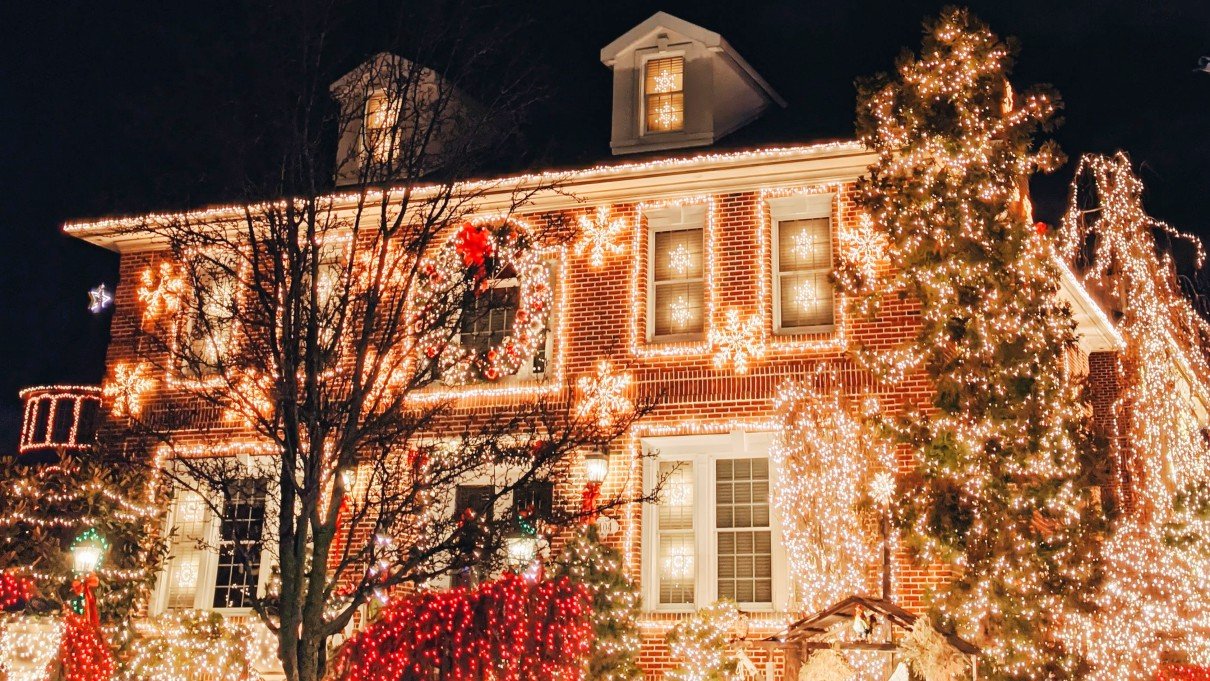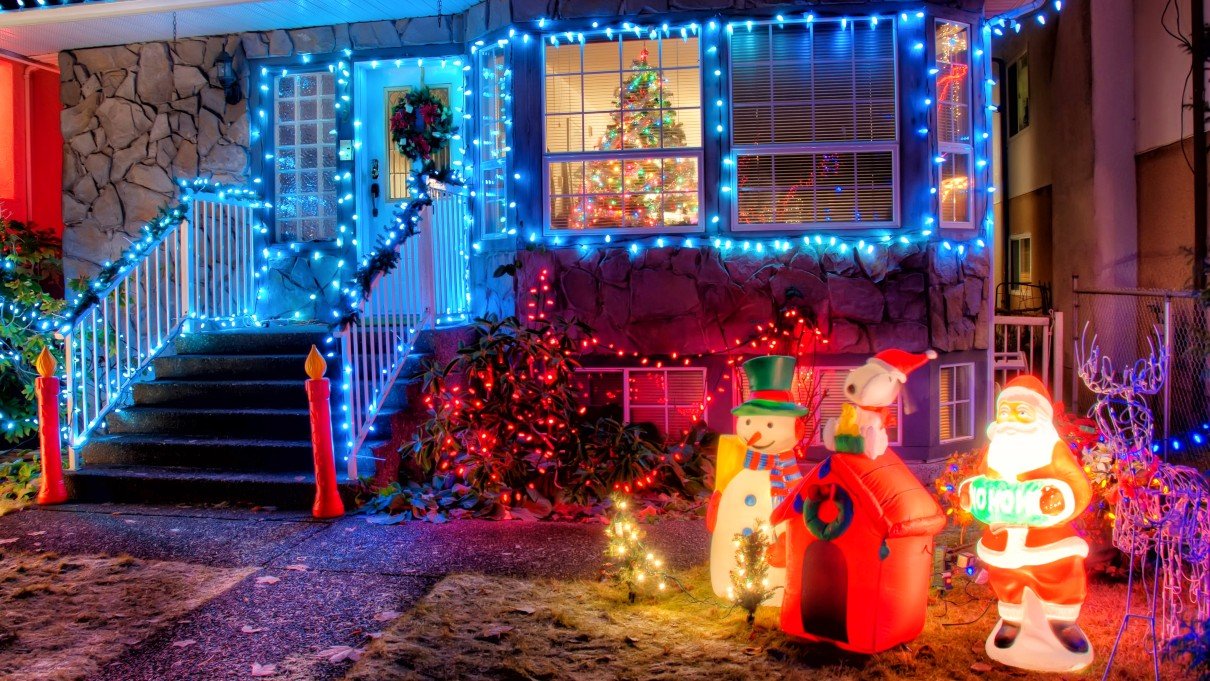Are Christmas Lights a Waste of Electricity?

Christmas lights are a staple of Christmas decorations, especially in the northern hemisphere where the darker days allow lights to show up brightly in the evenings.
It’s not uncommon to see a whole row of houses lit up, competing with one another on the most festive display.
This leads to a lot of electricity usage. Many Christmas movies use this to create a feud between families, including the dramatic shorting-out scene where all the lights suddenly turn off.
Are Christmas lights sustainable?
There are different kinds of Christmas lights: string lights and fairy lights.
Fairy lights are typically used in households, for outdoor, window, or tree decoration, while string lights have large bulbs that hang from a cable and are used for more public events.
Fairy lights are also known as mini-lights, twinkle lights, and holiday lights.
Powerley found that a string of mini lights uses 0.95kWh per day, while a string of mini LED lights uses up only 0.11kWh per day. The more strings you use, the more electricity is used up.
It takes approximately 700 lights to fill up a 7ft tree, so mini lights would use 6.65kWh per day and mini LED lights would use 0.77kWh per day.
The difference between them is pretty large, and it mostly comes down to the bulb used – mini lights use incandescent bulbs. They’re also the type that will stop working if even one bulb has burnt out.
Incandescent lights are the worst Christmas lights for the environment due to how much electricity they use and how unreliable they are in comparison to LED Christmas lights.
While LED Christmas lights still use up electricity, they use up 80% less energy than traditional string lights as seen above, and they’re also more reliable and durable. A string of LED Christmas lights will typically last half a decade if you store them properly outside of the Christmas season.
The advantages of solar-powered LED lights are:
- They generate their own electricity
- They use only renewable solar energy
- They can be used anywhere and they don’t trail cables around
- They require very little maintenance
You need to make sure that your lights are waterproof or have adequate protection from rainfall, strong winds, and continuous snowfall.
Solar-powered lights need to be cleaned and remain clear of dust, dirt, and debris. You can even keep them inside, though the solar panel works best when outside as glass reduces its efficiency.
When it’s time to put your lights up, set your solar-powered lights in the daylight for at least a day to help them charge up.
If you have lights that aren’t solar-powered, invest in a timer to make sure your lights are turned off during daylight hours and when you’re asleep. This will help you save a lot of energy and you don’t have to manually turn off your lights every day.
Are string and fairy lights bad for the environment?
Christmas lights have two main environmental impacts: light pollution and electricity usage.
Christmas tree lights give off less light pollution because they’re housed indoors, but they use the most electricity because looping solar-powered lights around a tree is less common than using LED lights plugged into the socket.
Keeping your Christmas lights on all day will use a massive amount of energy, so it’s best to only turn them on when you can see them at night. Turning off other lights like lamps and ceiling lights will reduce the amount of electricity wasted.
Outdoor lights are more easily powered by solar lights, but they also give off light pollution. This disrupts nocturnal ecosystems, affecting local wildlife like owls, bats, hedgehogs, and insects.
How much do Christmas lights contribute to light pollution?
Christmas in the northern hemisphere coincides with fewer daylight hours, so it’s hard to tell just how much of the light pollution during the holidays is due to Christmas lights.
NASA’s studies of light intensity changing over the year isolate city lights, allowing them to track when and how brightly homes are illuminated at night.
Light pollution washes out natural light from the stars, disrupts nocturnal ecosystems, and wastes energy. Light pollution is defined by the International Dark-Sky Association as “inappropriate or excessive use of artificial light”.
The majority of Christmas lights are used outdoors to decorate the roof, windows, and garden. Many lit decorations such as rattan light up reindeer are designed to be as bright as possible so neighbors and passersby notice them.

Because these lights don’t have any covering shades and are placed on the outside of buildings, their light spreads in all directions. This then becomes light pollution.
All outside artificial lights contribute to light pollution, and the spikes seen during the holiday season are influenced by the widespread use of lit decorations.
Do Christmas lights affect wildlife?
Unfortunately, this is where LEDs aren’t environmentally friendly. LED lights don’t just make it hard for your neighbors to sleep. Nocturnal animals are disrupted by even sparsely lit gardens throughout the year, let alone by massive Christmas displays.
Insects that navigate by using natural light sources – like moths – become disoriented due to artificial light, which leads them to bump against windows and hang about for spiders to catch them.
The more insects we attract to our home, the less there are in the wild ecosystem, leading predators to our homes, which can in turn open them up to their predators and other dangers, such as cars.
Garden birds can also be disturbed from sleep, leading them to sing before dawn. Robins are particularly sensitive to light, with American robins noted to initiate morning choruses earlier where there are higher levels of artificial twilight, compared to their more natural timing of civil twilight.
Cloud cover and mist can also intensify artificial light by trapping light closer to the ground.
The book
considers the impact of artificial lighting to have a great many negative impacts on wildlife – including mammals, birds, reptiles and amphibians, fishes, invertebrates, and plants.
Just some of the negative environmental impacts include migratory disruption leading to disorientation and death, and desynchronization of ant mating flights.
Light pollution also affects breeding cycles. One theory suggests even low levels of light pollution may block glow-worms from finding mates.
A further study agrees that light pollution has contributed to the decline of the glow-worm population globally.
Are there sustainable Christmas lights or sustainable alternatives to Christmas lights?
Because light pollution is caused by any form of light pollution, even the sustainable options of solar-powered LED lighting aren’t ideal for the environment.
The most sustainable alternative to Christmas lights is not to have any at all.
But if you’re still questioning whether to decorate with lighting, ask yourself these questions:
- Do you really need lighting decorations?
- Who is going to see it?
- Where will it be?
- How long is it going to be up for?
- When will you turn the lights off?
Those questions will help you decide how necessary your lighting is, and help you form a plan to be as environmentally friendly as possible.
A timer is an absolute must for Christmas lights, as it will help you save electricity and help you turn off artificial lights at a set time before nocturnal wildlife can be too affected.
You should also dim lights if you find yours are particularly bright, especially if they aren’t solar-powered. Solar-powered lights are usually dimmer, so they don’t emit as much light pollution.
Using a cover on the top of lights can reduce light pollution directed at the sky, which can help birds and bats. Avoid decorating your roof or chimney to help them even more.
If you have small ground visitors like hedgehogs or mice, keep lights off of the ground so they don’t get tangled up or trapped in the wires. Window light decorations are better because they remain where there is already artificial light and can’t be touched by local wildlife.
For your tree lights, make sure to add a timer to your lights or turn them off at the wall before you go to bed. When your Christmas tree lights are on, turn off any room lights to save energy and see them more. You’ll save electricity and your electricity bill by only turning them on when you want to see them.
Alternatively, you could reuse glittery Christmas cards and make sparkly decorations that catch light in the room instead. Glass ornaments can also reflect light.
